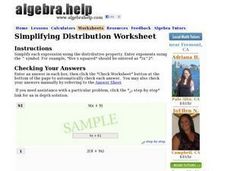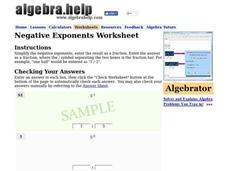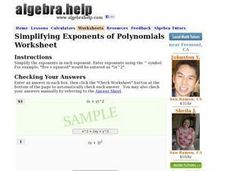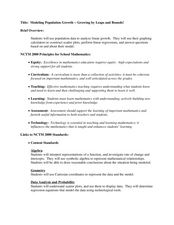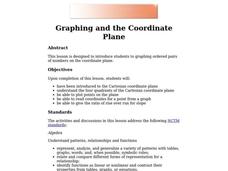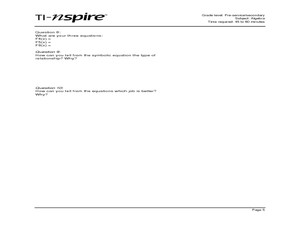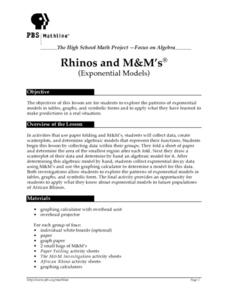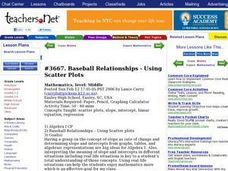Curated OER
Quadratic Formula
In this Algebra II learning exercise, 11th graders use the discriminant to determine the nature of the roots of a quadratic equation, determine the best method to use when solving a quadratic, and practice using the quadratic formula to...
Curated OER
The Truth About Triangles and Squares
Fourth graders investigate the patterns associated with both triangular and square numbers. They use counters as manipulatives to depict the numbers as needed but focus on problem solving using mental math techniques.
Curated OER
Voter Turnout
High schoolers solve problems using math. They complete a graph, using data from the 2000 presidential election results. Students predict and calculate the outcome of the election based upon the voting patterns.
Curated OER
Decoding Machine
Students are introduced to the concept of variables and their uses. In groups, they are given a code in which they must find the value of the missing words. To end the lesson, they find the value of words over ten letters long and their...
Curated OER
Simplifying Distribution Worksheet
In this simplifying distribution learning exercise, learners solve problems with one variable using the distributive property. They place their answers in the answer box provided on the internet. Students are able to view step-by-step...
Curated OER
FOIL Method Worksheet
In this FOIL method instructional activity, students with the "FOIL" method to solve equations with one to two variables. They may enter their answer on the internet instructional activity, and view step-by-step hints to solve the...
Curated OER
Negative Exponents Worksheet
In this negative exponent worksheet, students solve equations with negative exponents. They explore changing negative exponents to positive ones. Students simplify given problems changing them from exponential form to standard form. ...
Curated OER
Simplifying Using "The Order of Operations" Worksheet
In this order of operations worksheet, students solve equations with one variable using order of operations. Equations contain fractions, exponents, parenthesis, and the four basic operations of addition, subtraction, multiplication and...
Curated OER
Simplifying Exponents of Polynomials Worksheets
In this polynomial worksheet, students use FOIL to simplify polynomial equations with exponents. They evaluate expressions with two variables involving positive and negative integers. Students place their answers on the web page for...
Curated OER
Factoring Completely
In this factoring activity, students factor polynomial expressions to simplify them. Upon placing their answer in the appropriate box, students may receive immediate feedback. A link for step-by-step solutions is provided.
Curated OER
Modeling Population Growth
Learners collect data on population growth. In this statistics lesson, students graph their data and make predictions. They find the linear regression and the best fit line.
Power to Learn
How Much Space Do We Have?
Census-takers view the Internet to find the total population of a city and its total land area. They work with different mathematical scenarios that involve populations and land area in their city. They complete math problems and unit...
Curated OER
Super Duper Market
In this algebra worksheet, students rewrite word problems using algebraic symbols. These problems are interactive. There is an answer key.
Curated OER
Walking on Air
Young scholars collect and analyze data with a graph. In this statistics lesson plan, students use central tendencies to find the meaning of their data. They display the data on a Ti calculator.
Curated OER
Writing a Number Sentence
Third graders analyze word problems. In this number sentence lesson, 3rd graders evaluate word problems. Students create number sentences from word problems.
Curated OER
Relating Division and Subtraction
Third graders relate the process of division to subtracting equal groups. Through guided practice and teacher demonstration, they complete division problems using a subtraction method. Students complete problems independently for...
Curated OER
Compare Numbers Homework 2.1
In this comparing numbers learning exercise, students use the <, > or = signs to compare two and three digit numbers. There are also 6 problems comparing a number and an addition problem. Example: 40+6 and 64.
Curated OER
Graphing and the Coordinate Plane
Students examine the four quadrants of Cartesian coordinate plane. They play maze games and coordinate games to discover how to read and plot points on the plane. Students plot points on the coordinate plane and examine the ratio of...
Curated OER
TI-Nspire Activity: What Does Your Representation Tell You?
By learning to select the best representation for three meal plans, students compare three meal plans to determine the best choice. Data for the meal plans is sorted on a table, as an algebraic equation, and graphed on a coordinate grid....
Curated OER
Rhinos and M&M's
Students analyze patterns of exponential models by collecting data in paper folding and M&M investigations. They use graphing calculators to create scatter plots that lead to equations for the exponential models. They then apply this...
Curated OER
Domain and Range
Your class will grasp the concept of domain-and range on a graph by using their TI navigator to graph their lines. They observe the effect of a function and non-functions based on the domain and range.
Curated OER
Slopes of Lines
Students examine a graph and relate it to the real world situation it depicts. They investigate changes in an equation and the appearance of a line. They investigate the connection between the graph of a situation and the meaning of the...
Texas Commission on the Arts
The Quarter Fold
Little ones identify the US quarter and explore the concept of one-fourth or one-quarter. Using real coins or coin manipulatives, they divide a square piece of paper into quarters, discuss halves and quarters, and create a design that...
Curated OER
Baseball Relationships - Using Scatter Plots
Students use graphing calculators to create scatter plots of given baseball data. They also determine percentages and ratios, slope, y-intercepts, etc. all using baseball data and statistics.




